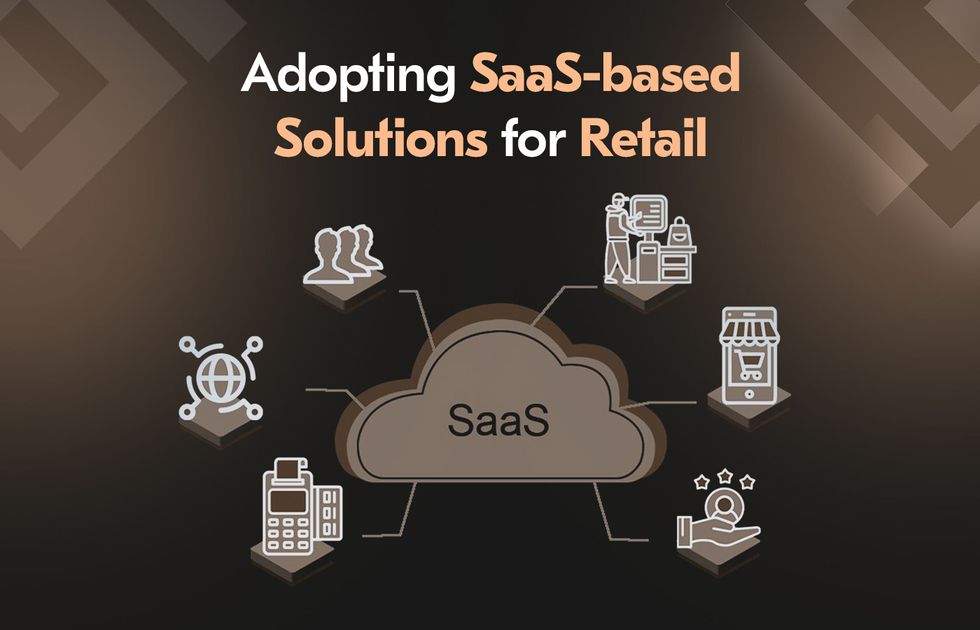
Key Takeaways
- With flexible architecture and subscription pricing, retail SaaS allows businesses to scale operations quickly without large upfront infrastructure investments.
- SaaS tools sync inventory across channels instantly, reducing overstock, preventing stockouts, and supporting smarter restocking decisions.
- Integrated customer data and behavior tracking enable tailored engagement, loyalty programs, and targeted marketing campaigns.
- The retail cloud market is expected to more than double by 2029, driven by mobility, demand for seamless customer experiences, and faster digital transformation.
Retail is steadily shifting to cloud-based platforms as businesses look for more efficient operations and better ways to connect with customers. SaaS retail solutions are at the center of this change, with 76% of companies having expanded their use of cloud tools, with most using six or more regularly.
Cloud-based software helps retailers optimize tasks like inventory tracking, accounting, and customer management, while also enabling smarter payments and AI-driven personalization. As mobile and IoT technologies become more integrated, retail SaaS tools are proving essential.
In the last 17+ years, Acropolium has delivered over 175 SaaS products to players from different industries. Taking insights from our retail IT expertise, we will guide you through the way SaaS changes modern retail with practical examples and case studies.
SaaS Retail Market Size

The retail cloud market is on a fast track. In 2025, it’s worth $44.95 billion. That’s a solid jump, driven by retailers moving away from outdated systems, the boom in mobile shopping, and the push to offer seamless experiences across all channels.
But the real momentum is just getting started. By 2029, the market is set to more than double, soaring to $100.16 billion with a growth rate of 22.2% a year. What’s fueling this leap is stronger cybersecurity, greener tech, and the need to keep up with evolving regulations.
At the same time, the total retail SaaS market is worth around $62.25 billion in 2025 and is expected to double to $126.84 billion by 2034, growing steadily each year at about 8.2%.
What is a SaaS Retail System?
SaaS retail tools refer to cloud-based applications designed specifically for retail businesses. Delivered over the internet and typically using a subscription model, this type of software allows retailers to access advanced tools without the need for expensive infrastructure or maintenance.
Most modern SaaS retail platforms operate on a multi-tenant architecture, meaning multiple businesses share the same software environment while keeping their data isolated and secure. This setup offers improved efficiency and reduced overhead for both vendors and users.
As more retail companies migrate away from on-premise solutions, SaaS migration becomes a key part of digital transformation strategies. For example, many retailers now adopt cloud ERP systems to unify inventory, finance, supply chain, and employee management under one centralized interface.
Adopting such SaaS solutions for retail results in faster rollout of features, lower upfront costs, AI integration for smarter insights, real-time collaboration across locations, and better scalability as your retail footprint grows.
Use Cases & Applications of Custom SaaS Retail Solutions
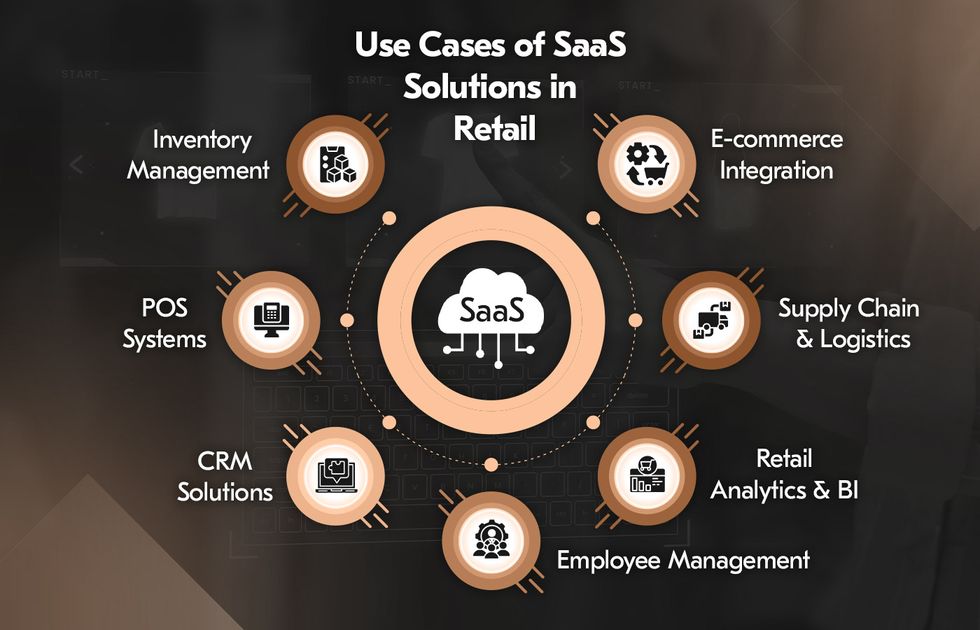
Retailers don’t all operate the same way, and that’s where custom software development comes in. Tailored retail SaaS solutions offer flexibility that off-the-shelf platforms often lack. From integrating AI-driven chatbots to building niche features into backend systems, custom retail SaaS platforms solve challenges that generic tools can’t.
Inventory Management
Cloud-based inventory management lets retailers track stock levels in real time, set automated restocking rules, and forecast demand based on sales history and location. These systems often integrate AI to reduce overstock and prevent out-of-stock scenarios.
Target uses an in-house inventory system enhanced with AI and machine learning to predict demand patterns and optimize product availability across stores. This system processes billions of forecasts each week.
Point of Sale (POS) Systems
Modern retail SaaS POS platforms allow seamless in-store transactions, often with mobile compatibility and offline support. Sales data is automatically synced with the cloud, enabling centralized control over product catalogs, promotions, and customer profiles.
Vend by Lightspeed provides a cloud-based POS used by thousands of retailers worldwide. It works offline using browser-based storage and syncs data once reconnected, ideal for stores with inconsistent internet.
Customer Relationship Management (CRM)
SaaS retail CRM tools help retailers collect and manage customer data, personalize communication, and track engagement across channels. They also enable loyalty programs and targeted marketing based on customer behavior.
Though not a traditional retailer, Airbnb is a great example to follow. It built a custom CRM to unify user interactions, bookings, and support data, leading to better segmentation and personalization at scale.
E-commerce Integration
Retail SaaS applications bridge physical stores and online channels, syncing products, orders, pricing, and customer data to maintain consistency across touchpoints. This ensures a smooth customer experience whether shoppers buy online or in-store.
Macy’s and The Home Depot use Rithum to manage orders across their websites, marketplaces, and physical stores, ensuring accurate availability and fulfillment.
Supply Chain & Logistics
Retailers use SaaS to monitor incoming shipments, warehouse capacity, and delivery timelines. Cloud dashboards provide visibility across suppliers and carriers, often enhanced with automation to reduce delays and stockouts.
Yves Rocher uses OneStock, a cloud-based order management system that improves shipping efficiency and reduces last-mile delivery costs.
Retail Analytics & BI
SaaS retail analytics tools give retailers real-time visibility into sales trends, customer behavior, and product performance. AI features help spot patterns, forecast demand, and guide smarter decisions across locations and channels.
Walmart uses real-time data and predictive analytics to optimize shelf layouts, restocking, and promotions, boosting efficiency and reducing inventory waste.
Employee Management
Cloud-based tools simplify scheduling, time tracking, and performance monitoring. These platforms help managers optimize staffing based on peak hours, sales data, or local labor laws.
Lightspeed is one of the retail SaaS examples that offers employee management features as part of its retail suite, including scheduling, permissions, and sales tracking for team members.
Advantages of Adopting SaaS for Retail Businesses
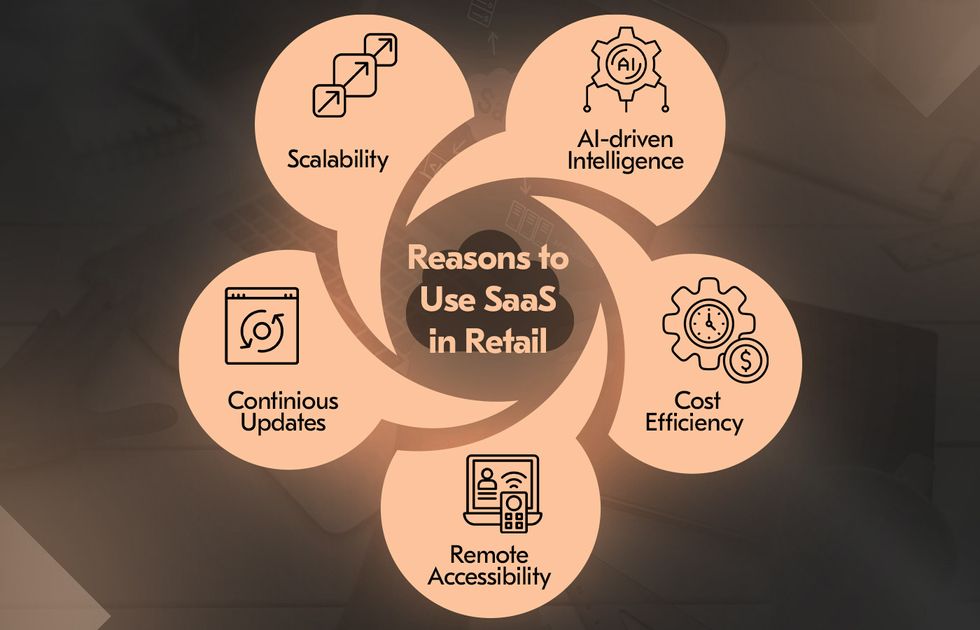
For retailers navigating constant market changes, evolving customer expectations, and growing operational complexity, retail SaaS tools offer a smarter, more adaptable way to run core systems. Unlike traditional software models, SaaS provides built-in flexibility, access to advanced technologies like AI, and the ability to scale quickly, all while keeping IT costs predictable.
Below are the key advantages that make SaaS a strategic asset in today’s retail environment.
Scalability
One of the most practical advantages of SaaS in retail is its ability to grow with your business. Whether you’re opening new stores, launching into new markets, or expanding your online presence, SaaS platforms can scale effortlessly to match your needs. There’s no need to overhaul infrastructure or set up new servers, as capacity can be adjusted on demand.
Flexible scalability makes it easy to respond to seasonal spikes, sudden demand surges, or even downsizing, without interrupting operations or inflating IT costs.
AI-Powered Intelligence
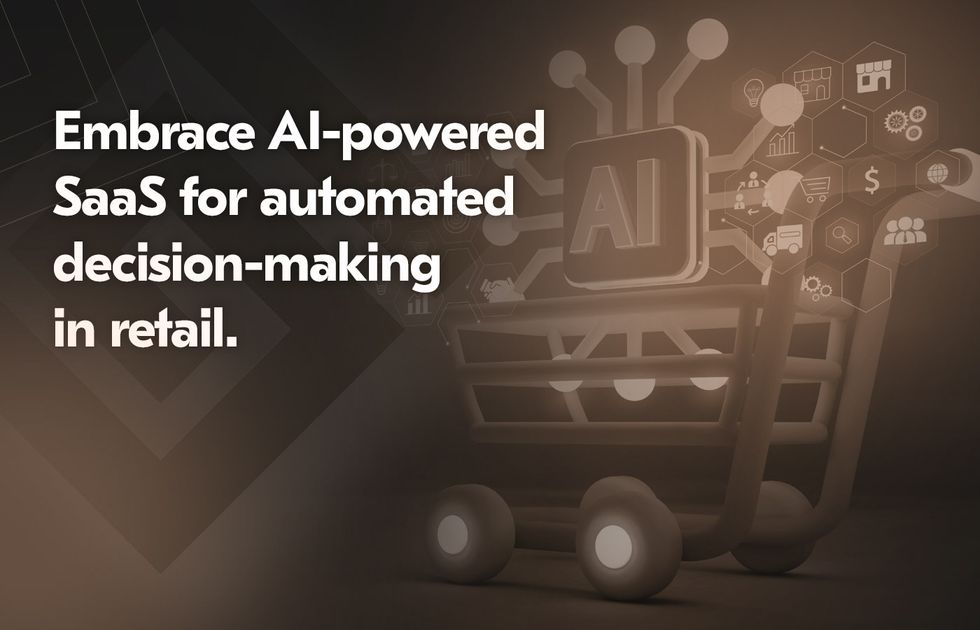
SaaS retail solutions often come with built-in AI capabilities that help automate decision-making. These tools can analyze sales data, identify shopping patterns, forecast demand, and even recommend personalized offers. AI reduces the guesswork in retail operations and speeds up reactions to customer behavior or market shifts.
From dynamic pricing to inventory optimization, retailers gain a competitive edge by acting on insights that would be difficult or impossible to extract manually.
Cost Efficiency
SaaS retail solutions eliminate the high upfront costs associated with traditional software. Instead of investing in hardware, licenses, and in-house maintenance, retailers pay a predictable subscription fee. This not only makes budgeting easier but also shifts IT spending from capital expenses to operational ones.
Although the initial cost of building SaaS is relatively high, it pays off with long-term savings.
Maintenance, support, and updates are all handled by the provider, freeing internal teams to focus on higher-value tasks. Over time, this model lowers overall ownership costs and makes advanced, enterprise-level tools more accessible.
Remote Accessibility
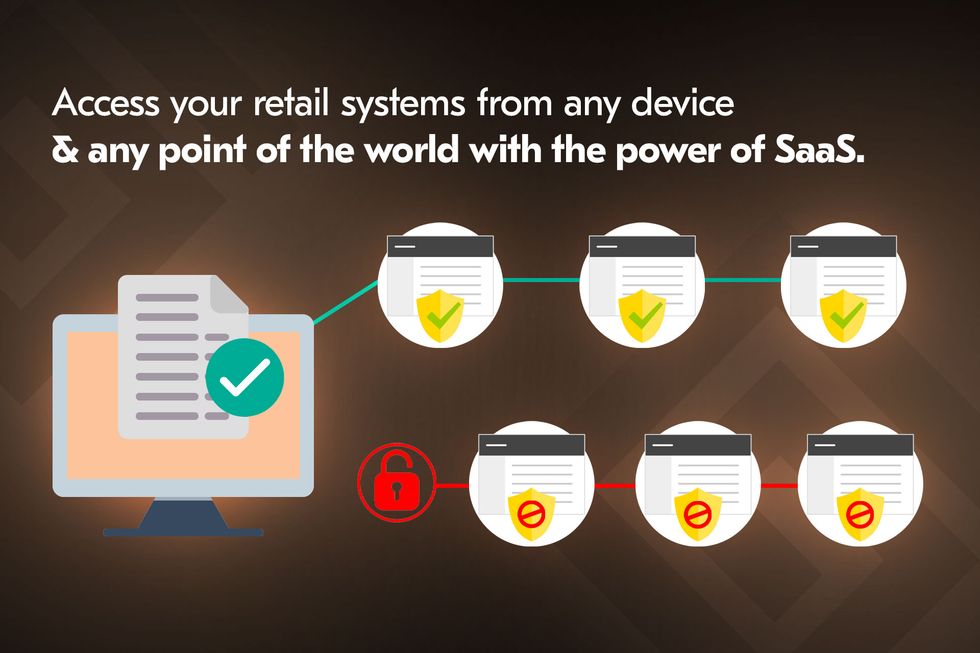
With SaaS, retail systems are accessible from anywhere with an internet connection. Staff in different locations — at a store, warehouse, or head office — can log in to the same system and see up-to-date information in real time.
This level of access improves coordination across teams and locations, enabling better decision-making and faster responses. It also supports mobile devices, allowing employees to check inventory or sales dashboards on the go, directly from a tablet or smartphone.
Continuous Updates and Innovation
Retail SaaS platforms evolve continuously. Updates, new features, and security improvements are delivered automatically, without requiring manual installs or downtime. Retailers always have access to the latest tools, whether that’s a new reporting module, AI functionality, or an improved user interface.
This keeps businesses ahead of the curve and reduces the risk of using outdated software that can’t keep up with industry trends or customer expectations.
Adopting SaaS in Retail: Challenges & Solutions
While retail SaaS brings scalability, automation, and cost advantages to retail, the transition from traditional systems requires thoughtful planning. Challenges often arise in areas such as security, system compatibility, customization, and offline functionality, especially for businesses with physical locations or legacy infrastructure.
Data Security & Compliance
Retailers are responsible for large volumes of sensitive customer and transaction data, making security a top priority. Compliance with standards like GDPR, PCI-DSS, and CCPA is non-negotiable, particularly when processing payments or handling personally identifiable information (PII).
SaaS retail solutions must be selected with strict security protocols in place, including end-to-end encryption, multi-factor authentication, access control, regular vulnerability testing, and audit logs. However, selecting the right platform is only part of the equation.
Many retailers turn to staff augmentation to bring in cloud security specialists or compliance consultants during rollout.
Integration with Legacy Systems
Legacy software like on-premise ERPs or traditional POS systems can’t always be replaced overnight. Many retailers instead opt to integrate newer cloud-based tools gradually. A modern tech stack using APIs, webhooks, and middleware allows these older systems to communicate with SaaS platforms in real-time without full replacement.
To make this process more manageable, some retailers turn to staff augmentation, bringing in integration architects or backend engineers for a limited time. These external experts work with internal teams to build secure bridges between systems, enabling a smooth phase-in of cloud capabilities while keeping the core business uninterrupted.
Customization & Scalability
Retailers with niche workflows, regional product lines, or specialized customer journeys often find that an off-the-shelf SaaS retail solution doesn’t quite fit. Custom development becomes essential in these cases, not only to align features with business needs but also to ensure that the system can grow as operations expand.
The ability to scale SaaS solutions across multiple stores or geographic regions depends heavily on choosing a flexible architecture: multi-tenant support, modular components, and elastic infrastructure. With this setup, retailers can start small and roll out updates or expansions without significant downtime or redevelopment.
Offline Mode Requirements
Brick-and-mortar stores don’t always have reliable internet connections, especially in high-traffic areas or remote locations. To maintain sales, inventory tracking, and customer interactions during outages, SaaS platforms need to offer robust offline capabilities.
Leading SaaS retail providers solve this by storing critical data locally using technologies like HTML5 local storage or embedded databases. When the network is back, the system syncs with the cloud automatically. This ensures uninterrupted operations and prevents data loss, even in challenging connectivity environments.
Custom SaaS Retail Software Development with Acropolium
Our dedicated teams blend deep AI knowledge with proven SaaS development practices, ensuring every solution is secure, compliant, and designed around the customer experience.
We staff projects with specialized SaaS developers who leverage modern frameworks and flexible infrastructure to solve today’s retail challenges and turn user interactions into actionable insights.
Following ISO-certified processes, we have built and modernized over 23 retail platforms. When creating bespoke SaaS solutions, we paired our in-house AI specialists with seasoned offshore developers to infuse intelligent features and seamless scalability.
Below, you can see how our approach translates to business success.
E-Commerce Solution Modernization for a UK Retailer
A high-volume UK retail brand needed to replace its outdated e-commerce platform to meet growing customer expectations and mobile demands.
Solution
We rebuilt their platform to make it faster, more mobile-friendly, and easier to connect with modern tools. AI-powered search helped customers find what they needed quicker, while backend improvements made daily operations smoother and more cost-effective.
Results
- 40% cut in infrastructure costs
- 22% revenue growth in 6 months
- 65% faster page loads
- 35% increase in mobile conversions
Omnichannel Integration for Multi-Platform Retailer
A retail brand selling across stores, online, and mobile had trouble keeping everything in sync, notably inventory and customer data.
Solution
Our developers delivered a centralized system where all sales channels worked together in real time. This gave the company full visibility into stock levels, improved delivery speed, and used AI to personalize offers and recommendations.
Results
- 25% faster order processing
- 22% improvement in customer loyalty
- 18% overall revenue growth
Final Thoughts
SaaS in retail has become instrumental for smarter, more responsive, and more connected operations, from real-time inventory management and omnichannel commerce to predictive analytics and customer personalization.
However, these gains are only fully realized when the technology is implemented thoughtfully, with attention to compliance, system compatibility, and user experience. That’s where tailored development makes a difference for retailers dealing with complex workflows or legacy software.
At Acropolium, we help companies navigate this transition with a subscription-based cooperation model that offers flexible, long-term development support.
Whether you’re modernizing an e-commerce platform, building a scalable CRM, or integrating online and in-store systems, our dedicated teams deliver high-impact SaaS solutions that evolve with your business.
Let’s uncover new growth opportunities for your retail business!









![Renewable Energy Software Development in 2025 [Use Cases & Solutions]](/img/articles/software-for-renewable-energy-sector/img01.jpg)


![9 Big Data Use Cases Across Major Industries [2025 Guide]](/img/articles/big-data-use-cases-across-major-industries/img01.jpg)
![Retail Software Development Guide for 2025: [Features + Cost]](/img/articles/custom-retail-software-development/img01.jpg)
![8 Machine Learning Use Cases in Key Industries [2025 Guide]](/img/articles/use-cases-for-machine-learning-adoption-in-key-industries/img01.jpg)